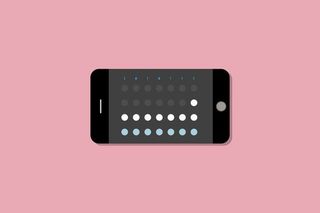
A Period‑Tracking App That’s Effective for Irregular Cycles
The app can support up to 10 days of variation in a menstrual cycle.

Dot, a period-tracking app that bills itself as a ‘contraceptive’ app, has been found in a study to be effective at flagging highly fertile days, even for people with unusually short, unusually long, or even irregular menstrual cycles.
The app says it can track cycles anywhere from 20 to 40 days, with up to 10 days of possible variation in cycle length, and only requires users to enter their age and start date of each period. So far, so good. But it’s worth noting Dot achieves this not by divining your personal fertility cycle, per se, as much as by tracking the most-extreme possible version of it and advising you to use a condom or avoid sex on days it deems likely to be highly fertile – that is, ‘high risk’ for pregnancy.
From first use, Dot “flags days as ‘high risk’ more conservatively,” explained Dot creator Leslie Heyer in an e-mail. “As a user enters more information, the algorithm incorporates her cycle data and makes more accurate assessments of her individual pregnancy risk for each day of her cycle. As it does this, it can then narrow the days that it identifies for a given user as high risk.”
It’s this conservatism that gives Dot a better shot at predicting ovulation, that is, ‘high risk’ days. That said, it’s not rocket science; the less you have sex, and/or the more you use a condom, the more effective you are at not getting pregnant, with or without an app.
Still, there’s a lot to like about Dot. It’s easy to use. It’s not smugly feminine. It limits the data it collects to use patterns and age; any notes about mood or sexual activity remain on users’ devices, Heyer said in her e-mail. Dot also does not rely on third-party software that could mine users’ data unbeknownst to the company (as was the case with a similar period-tracking app, Flo).
But then, there’s a lot to like about so-called ‘digital contraceptives’ in general. Among an increasingly digitized generation, who came of fertile age amid ‘all-natural’ movements that shun hormones in our food, let alone in our own bodies, the promise of an app that can help you keep from getting pregnant is fairly dazzling.
But it’s a ‘birth control’ app that only works if you remember to use actual birth control. This point is at the heart of criticism of femtech that bills itself as contraception – it’s not actually contracept-ing anything, just telling users when they should definitely use a method of actual birth control, and when it’s okay to risk getting pregnant — that is, when it’s probably okay; you never actually know, given that it’s possible to get pregnant at any point in your cycle. The first app approved as a method of contraception by the U.S. Food and Drug Administration, Natural Cycles, discovered this the hard way when authorities in Sweden started investigating it, after one Stockholm hospital found 37 of the 668 abortions sought there were by women who had been using Natural Cycles to avoid pregnancy.
Which makes ‘contraceptive apps’ in general a 21st century version of the Rhythm Method, a process of fertility tracking that dates back to the 1920s – old wine, in a new, touch-screen bottle.
Still, old wine tastes good and can get you drunk. Dot isn’t useless; it can help you track your menstrual cycle, even if it’s irregular, which is more than many other period-tracking apps offer. Just don’t forget you need a condom, if you don’t want to get pregnant (or an STD).
Correction: This article has been updated to clarify that Dot is not, in itself, a method of contraception, but rather an app that aids women in making effective decisions around condom use and/or abstention from sex.
Liesl Goecker is The Swaddle's managing editor.
Related


Phone Stress Is a Real Thing and It Might Be Shortening Our Lives
